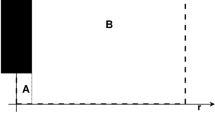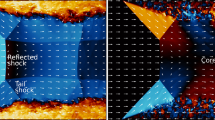Abstract
A method to estimate the propagation speed of a three-dimensional ignition front in Direct Numerical Simulation (DNS) is discussed. The objective is to contribute to the design of advanced numerical tools for the study of sporadic pre-ignition kernels leading to violent pressure waves, which may for instance damage moving parts in engines. Estimating the speed of a propagating ignition front in three-dimensional DNS, before it is occurring, is not an easy task, because this speed scales as the inverse of the spatial gradient of the time left till ignition, which is a priori an unknown quantity. The proposed approach introduces, for every point of the DNS, an estimation of the time left till ignition, which is obtained from reactors dynamically parameterized from the time evolving DNS results. This provides a three-dimensional distribution of ignition delays at every instant in time of the DNS fields. The time evolution of the ignition speed is then computed from the space derivative of the ignition delay field. Only the pre-ignition phase is examined and the demonstration of the method is made with oversimplified chemistry, in order to apply it to an existing rapid compression machine, in which the mixture composition is homogeneous, whereas the temperature distribution is non-uniform due to heat-transfer at wall. The two expected distinct ignition regimes are reported. In the first, ignition propagates at the speed of sound, or even above, and occurs over a large portion of the combustion chamber, with a strong and sudden pressure increase. The second ignition regime is much more localized in space and with a propagation mechanism pertaining to a deflagration mode. A method is also discussed to delineate in the DNS between ignition influenced by either the constant pressure or the constant volume canonical behaviors.
Similar content being viewed by others
References
Bartenev, A.M., Gelfand, B.E.: Spontaneous initiation of detonations. Prog. Energy Combust. Sci. 26(1) (2000)
Clavin, P.: Dynamics of combustion fronts in premixed gases: from flames to detonation. Proc. Comb. Inst. 28, 569–585 (2000)
Colin, O., Pires da Cruz, A., Jay, S.: Detailed chemistry-based auto-ignition model including low temperature phenomena applied to 3-d engine calculations. Proc. Combust. Inst. 30(2), 2649–2656 (2005)
Dec, J.: Advanced compression-ignition engines - understanding the in-cylinder processes. Proc. Combust. Inst. 32(2), 2727–2742 (2009)
Domingo, P., Vervisch, L., Veynante, D.: Large-eddy simulation of a lifted methane-air jet flame in a vitiated coflow. Combust. Flame 152(3), 415–432 (2008)
Ducros, F., Laporte, F., Soulères, T., Guinot, V., Moinat, P., Caruelle, B.: High-order fluxes for conservative skew-symmetric-like schemes in stuctures meshes: Application to compressible flows. J. Comput. Phys. 161, 114–139 (2000)
Etheridge, J., Mosbach, S., Kraft, M., Wu, H., Collings, N.: Modelling cycle to cycle variations in an si engine with detailed chemical kinetics. Combust. Flame 158(1), 179–188 (2011)
Gottlieb, S., Shu, C.: Math. Comput. 67(221), 73–85 (1998)
Gu, X., Emerson, D., Bradley, D.: Modes of reaction front propagation from hot spots. Combust. Flame 133(1-2), 63–74 (2003)
Guibert, P., Keromnes, A., Legros, G.: Development of a Turbulence Controlled Rapid Compression Machine for HCCI Combustion. SAE Technical Paper 2007-01-1869 (2007)
Guibert, P., Keromnes, A., Legros, G.: An Experimental Investigation of the Turbulence Effect on the Combustion Propagation in a Rapid Compression Machine. Flow Turb. Combust. 84(1), 79–95 (2010)
Jay, S., Colin, O.: A variable volume approach of tabulated detailed chemistry and its applications to multidimensional engine simulations. Proc. Combust. Inst. 33(2), 3065–3072 (2011)
Kalghatgi, G.T., Hildingsson, L., Harrison, A.J., Johansson, B.: Autoignition quality of gasoline fuels in partially premixed combustion in diesel engines. Proc. Combust. Inst. 33(1), 3015–3021 (2011)
Lodato, G., Domingo, P., Vervisch, L.: Three-dimensional boundary conditions for direct and large-eddy simulation of compressible viscous flows. J. Comput. Phys. 227(10), 5105–5143 (2008)
Lodato, G., Vervisch, L., Domingo, P.: A compresssible wall-adapting similarity mixed model for large-eddy simulation of the impinging round jet. Phys. Fluids 21(035), 102 (2009)
Lodier, G., Merlin, C., Domingo, P., Vervisch, L., Ravet, F.: Self-ignition scenarios after rapid compression of a turbulent mixture weakly-stratified in temperature. Combust. Flame 159(11), 3358–3371 (2012)
Mastorakos, E.: Ignition of turbulent non-premixed flames. Prog. Energy Combust. Sci. 35(1), 57–97 (2009)
Merlin, C., Domingo, P., Vervisch, L.: Immersed boundaries in large eddy simulation of compressible flows. Flow Turb. Combust. 90(1), 29–68 (2013)
Niu, Y.S., Vervisch, L., Tao, P.D.: An optimization-based approach to detailed chemistry tabulation: Automated progress variables definition. Combust. Flame 160(4), 776–785 (2013)
Peters, N., Kerschgens, B., Paczko, G.: Mega-knock in super-charged gasoline engines interpreted as a localized developing detonation. In: Proceedings of the 4th International Conference on Knocking in Gasoline Engines (2013)
Peters, N., Kerschgens, B., Paczko, G.: Super-knock prediction using a refined theory of turbulence. In: SAE technical paper, pp 2013–01–1109 (2013)
Poinsot, T., Lele, S.K.: Boundary conditions for direct simulations of compressible viscous flows. J. Comput. Phys. 1(101), 104–129 (1992)
Sreedhara, S., Lakshmisha, K.: Autoignition in a non-premixed medium: DNS studies on the effects of three-dimensional turbulence. Proc. Combust. Inst. 29(2), 2051–2059 (2002)
Subramanian, V., Domingo, P., Vervisch, L.: Large-Eddy Simulation of forced ignition of an annular bluff-body burner. Combust. Flame 157(3), 579–601 (2010)
Zeldovitch, Y.: Regime classification of an exothermic reaction with nonuniform initial conditions. Combust. Flame 39(2), 211–214 (1980)
Zeldovitch, Y., Librovich, V., Makhviladze, G., Sivashinsky, G.: On the development of detonation in a non-uniformly preheated gas. Astronautica Acta 15, 313–321 (1970)
Author information
Authors and Affiliations
Corresponding author
Rights and permissions
About this article
Cite this article
Lodier, G., Domingo, P. & Vervisch, L. Quantification of the Pre-ignition Front Propagation in DNS of Rapidly Compressed Mixture. Flow Turbulence Combust 94, 219–235 (2015). https://doi.org/10.1007/s10494-014-9577-x
Received:
Accepted:
Published:
Issue Date:
DOI: https://doi.org/10.1007/s10494-014-9577-x




